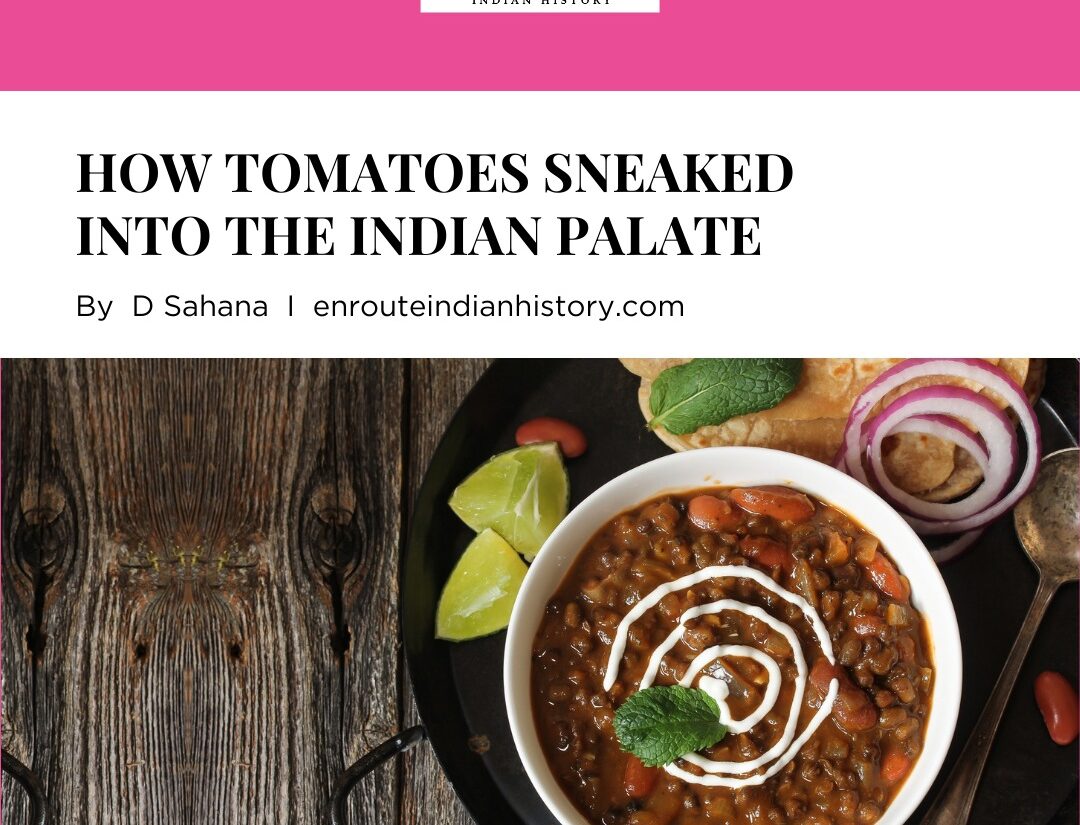
Potatoes and tomatoes are some of the vegetables which form the core of many Indian dishes; this is especially true for tomatoes as they don’t just create the base for savoury curries such as dal makhani and butter chicken, but also are a star of dishes such as tomato pachadi, Benaras tomato chaat and others! This is the story of how this humble plant has had an adventurous journey from the Americas and spread to the world. Indian Tomatoes captured the hearts of many people worldwide due to their tartness and tanginess; Indians also felt the same; however, unlike chillies and other new world foods, tomatoes took a later entry into the Indian kitchens.
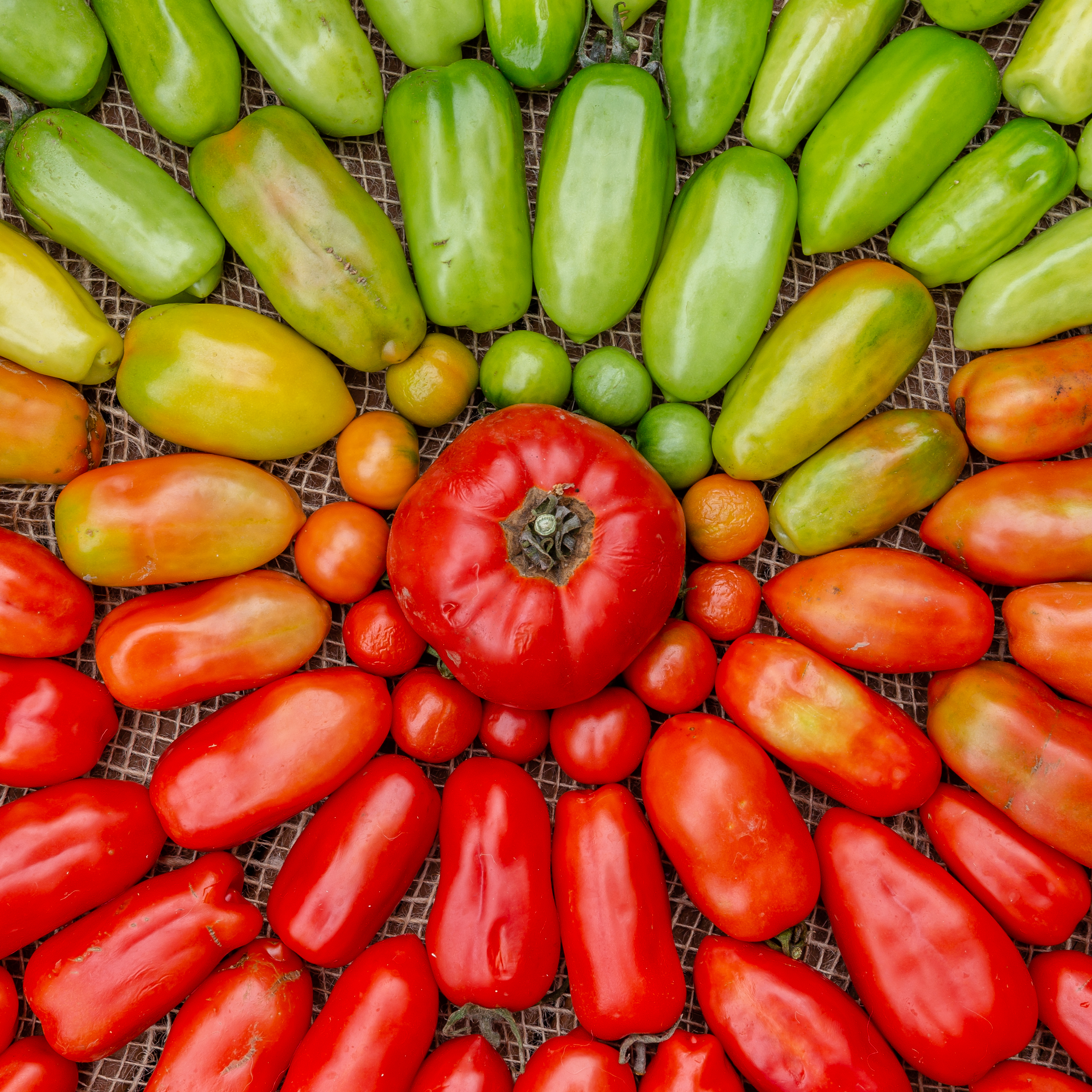
Tomatoes (Source: Michal Klajban,https://commons.wikimedia.org/w/index.php?curid=88576070)
THE JOURNEY OF INDIAN TOMATOES
As we know, tomatoes originated in the Americas. K T Achaya writes that the tomato (Solanum lycopersicum) was called “tomatl” by the Nahuas of Mexico. He writes that the tomato reached Europe in 1550 and was first adopted in Italian cuisine. While the Italians were consuming tomatoes, he writes, England, on the other hand, was much slower in accepting this new plant as it was associated with the plants they deemed poisonous. Ravi Mehta writes that a nickname for the tomato was the “Poison Apple”, as many aristocrats used to get sick and die after consuming these tomatoes. However, the reason why this occurred was due to the nature of the crockery they used. They consumed their meals using pewter plates, which used to react to the acidity of the tomatoes and ultimately caused lead poisoning.
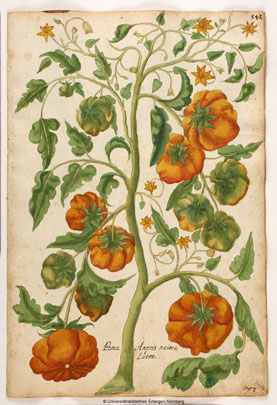
Illustration of a tomato plant (source:https://traditom.eu/project/history/)
As mentioned before, the journey of tomatoes in India was fascinating as, unlike other New World fruits, tomatoes entered the subcontinent much later and came via the British. Achaya writes that tomatoes might have made way only by the late 18th century.
IS TOMATO A VEGETABLE OR A FRUIT?
Rahul Verma writes that, like Europe, tomatoes too were viewed with ambiguity. However, this ambiguity came due to the nature of tomatoes. The 19th century United States debated whether tomato was a fruit or a vegetable. The US Government had imposed a 10 per cent tax on imported vegetables to protect American farmers, leading to appeals for making tomatoes a fruit instead of a vegetable. However, the Supreme Court in Nix v. Hedden (1893) case soon decided that tomatoes be classified as vegetables rather than fruits for tariffs, imports and customs. The reason was how the tomatoes were consumed, as tomatoes were consumed more like vegetables than fruits.
This debate, however, did not rise in India as Indians were accustomed to tomatoes as vegetables and agents for adding colour to dishes and bringing tartness.
The culinary world also thinks of the tomato as a vegetable; however, the scientific world considers it a fruit. But why this discrepancy? For this, one must consider why something is a fruit or a vegetable. A fruit is the mature ovary of a flowering plant with seeds inside it resulting from fertilisation. A vegetable, however, is an edible portion of a plant, such as leaves, stems, tubers, bulbs or flowers. A tomato contains seeds and grows from the flower of the tomato plant; hence, it is a fruit. Since fruits are also of many types, tomato is further categorised as a berry under the fruits category as berries contain one or many seeds surrounded by a fleshy, soft material called a mesocarp. This makes a tomato a berry.
WHEN DID TOMATOES GAIN POPULARITY?
Vir Sanghavi writes that tomatoes were first used in Bengal and the East. The other significant development leading to the popularity of tomatoes was the rise of Punjabi restaurant cuisine in Delhi in the 1950s. Traditionally, Punjabi black dal had no tomatoes, and Punjabi mutton curries did not either. That changed in the post-Partition era with the popularity of dishes such as Dal Makhani and Butter Chicken, which depended heavily on tomato purée.
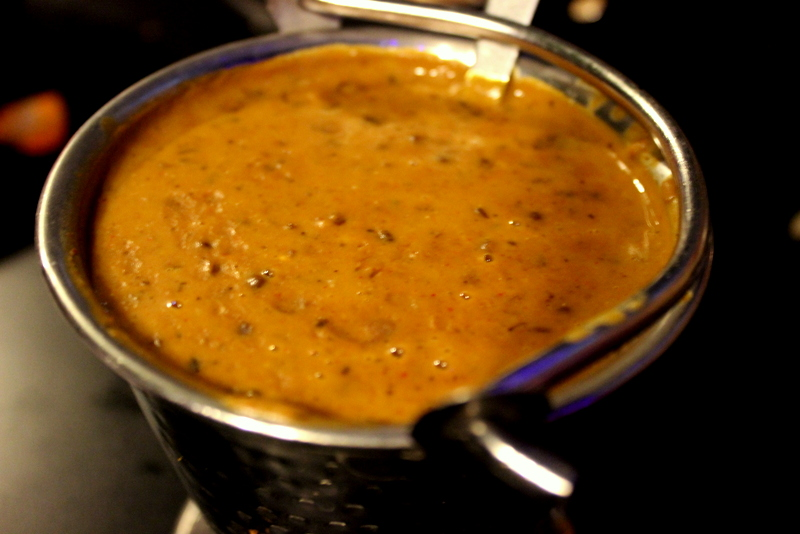
Dal Makhani, which uses tomato purée as the base of the dish (Source: Sanya1492 -Wiki Commons, https://commons.wikimedia.org/w/index.php?curid=40988973)
He argues that the reason why tomatoes gained such popularity in India was due to their sourness. He further claims that one of the other reasons for this development was due to “umami”. Umami refers to the fifth taste. It means “delicious savoury taste” in Japanese. He writes that the discovery of umami flavours in India influenced the development of Indian food from 1960 onwards. This was caused by the popularity of butter chicken(which used tomato purée), Chinese food and the sushi boom, which used soy sauce. Tomato purée and soy sauce have intense umami flavours, which led to tomatoes gaining fondness from the masses.
SKEWED REPRESENTATIONS OF TOMATOES IN INDIAN CUISINE
Tomatoes, despite being the mainstay in Indian cuisine, do not have the same popularity everywhere. In many parts of South India, the Northeast, and regions like Jammu and Kashmir, the tomato remains a lesser-used ingredient. Vir Sanghavi points out that even though tomatoes are famous, it is in fact, restaurants and commercial establishments that rely more on tomatoes than homes. There are also some places where tomatoes are not represented, including old Indian temples. Vir Sanghavi also points out that traditional Muslim cooking does not use tomatoes either. He further adds how traditional Awadhi cuisine does not include tomatoes and that there are no tomatoes in biryani and no tomato purée in Kormas. Even Hyderabadi cuisine, which has more sour elements than Lucknow, does not use tomatoes in their biryanis.
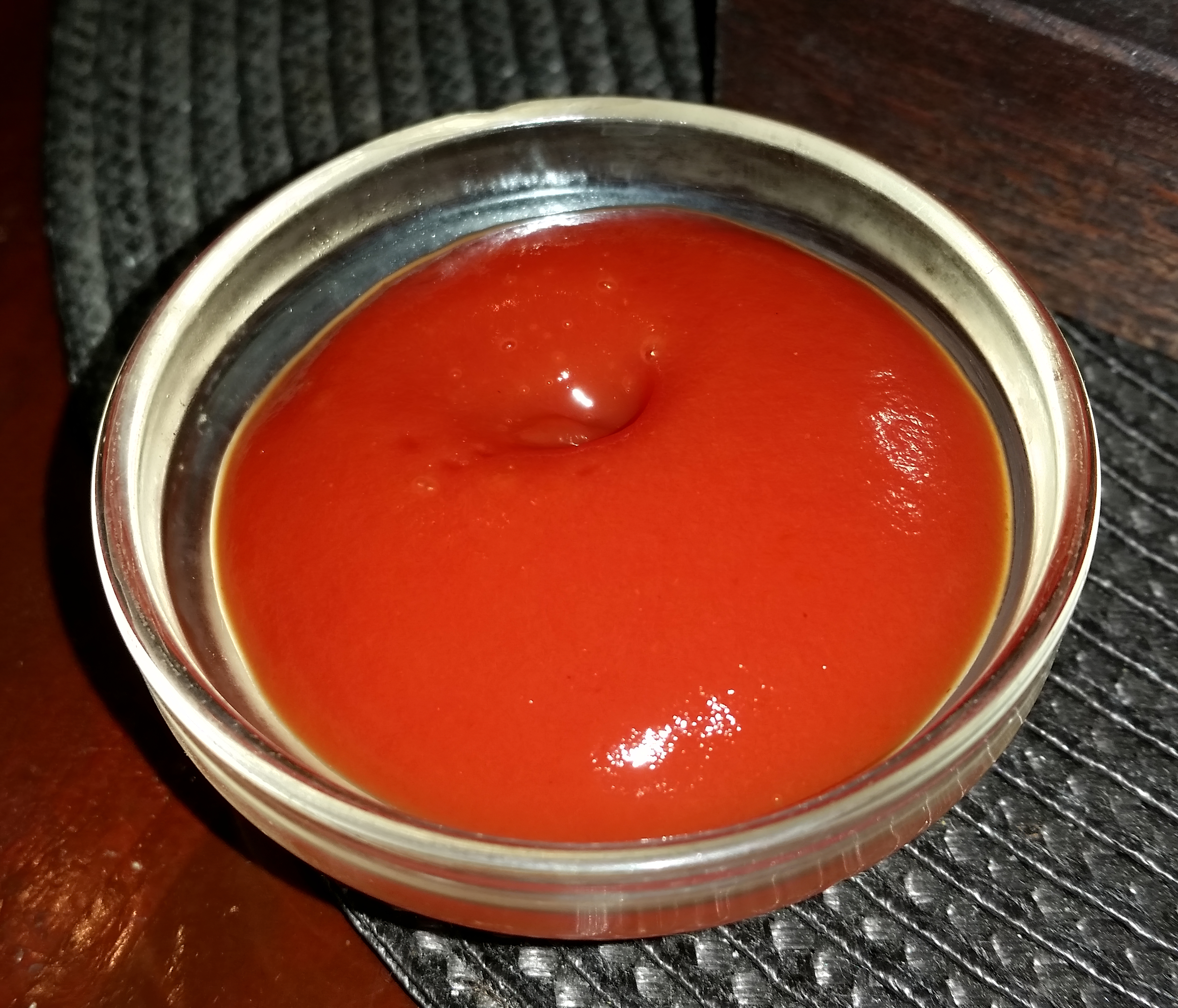
Tomato ketchup, which is rich in umami flavour (source: Kim Holger Kelting, https://commons.wikimedia.org/w/index.php?curid=81834521)
VARIETIES OF TOMATO
Due to the nature and the spread of tomatoes, there are different varieties, each differing in colour, size, seed variety and sweetness or tartness. There are over 10,000 varieties of tomatoes worldwide, ranging from Roma tomatoes, Kumato, San Marzano, and Campari, which are grown in countries such as Spain, Italy, the United States, etc. The Indian tomatoes generally fall under two major categories, the Deshi and the Hybrid. Vir Sanghvi writes that desi tomatoes are grown from local seeds, and hybrid tomatoes are made from breeds developed by various agricultural institutions. These hybrid tomatoes include Arka Vishesh, Arka Apeksha, Arka Meghali etc. These hybrid tomatoes are made to maximise yield. They are made for different purposes as different tomatoes are used for canning and making ketchup than tomatoes, which are used for fresh markets.
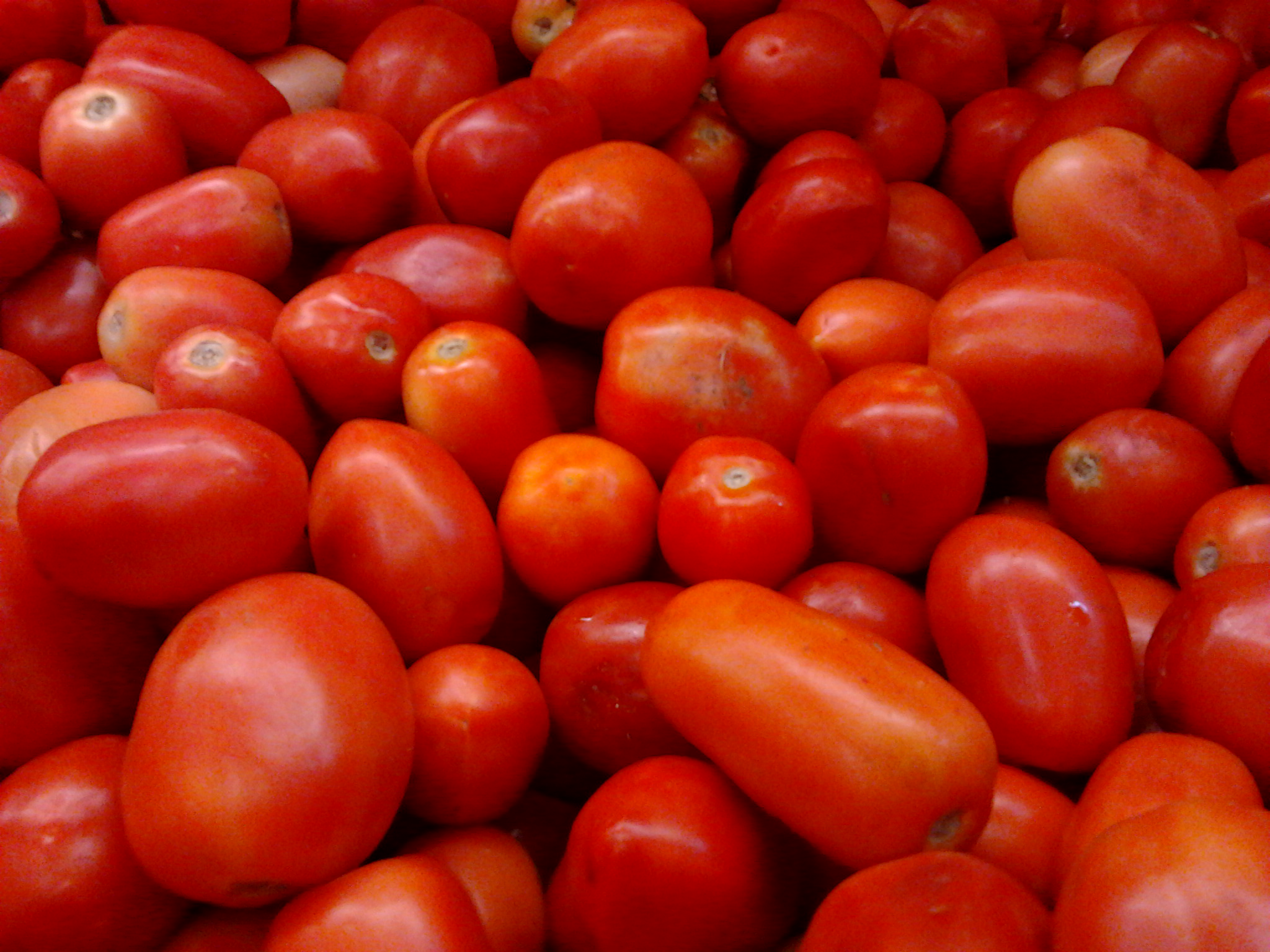
Hybrid tomatoes in Bangalore( source: Aravind Sivaraj, https://commons.wikimedia.org/w/index.php?curid=19046320)
Overall, tomatoes have had a fascinating history of being plants grown in the Americas to travel worldwide and being staples in different world cuisines. In India, too, despite coming in later, it gained popularity and became a mainstay in many Indian curries and other side dishes. It is now practically impossible to associate Indian food without tomatoes as it is a part of almost every single dish, sometimes the main dish itself! Even though there are exceptions, tomatoes still bring in their tartness and umami in many dishes. Hence, they are extremely popular and are consumed either raw, cooked, ripe, or even unripe.
REFERENCES:
Achaya, K.T. (1998) Indian Food: A Historical Companion. Second.Delhi, India: Oxford University Press.
Mehta, R. (2017) ‘History of Tomato (Poor Man’s Apple),’ IOSR Journal of Humanities and Social Science (IOSR-JHSS), 22(8). https://doi.org/10.9790/0837-2208033134.
Verma, R. (2023) Remember, it took time to embrace Tomato. https://www.tribuneindia.com/news/features/remember-it-took-time-to-embrace-tomato-525992#goog_rewarded.
Sanghvi, V.(2023). https://www.virsanghvi.com/Article-Details.aspx?key=2069.
Tomato | Page 2 | ICAR-Indian Institute of Horticultural Research. https://iihr.res.in/varieties-crop-name/tomato?page=1.
Fairfax County Master Gardeners Association, Inc. and Novitske, R. (2019) Tomatoes are berries and strawberries are not. https://www.fairfaxgardening.org/wp-content/webdocs/pdf/TomatoesAreFruit.pdf.
- Culinary journey of tomatoes in India
- Evolution of Indian tomato curries
- Historical of Indian food
- Indian food history
- Indian tomato curry
- Influence of tomatoes in Indian cuisine
- Tomato recipes Indian cuisine
- Tomato spices Indian cuisine
- Tomato-based dishes in Indian culture
- Tomatoes in traditional Indian dishes
















